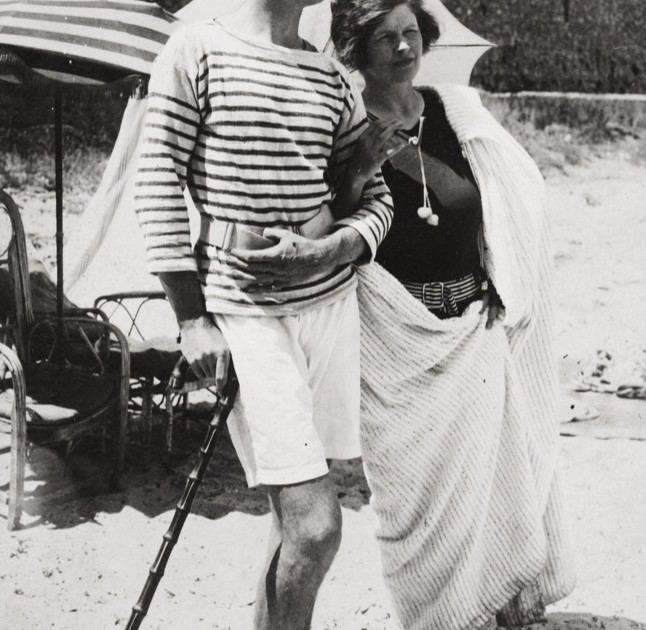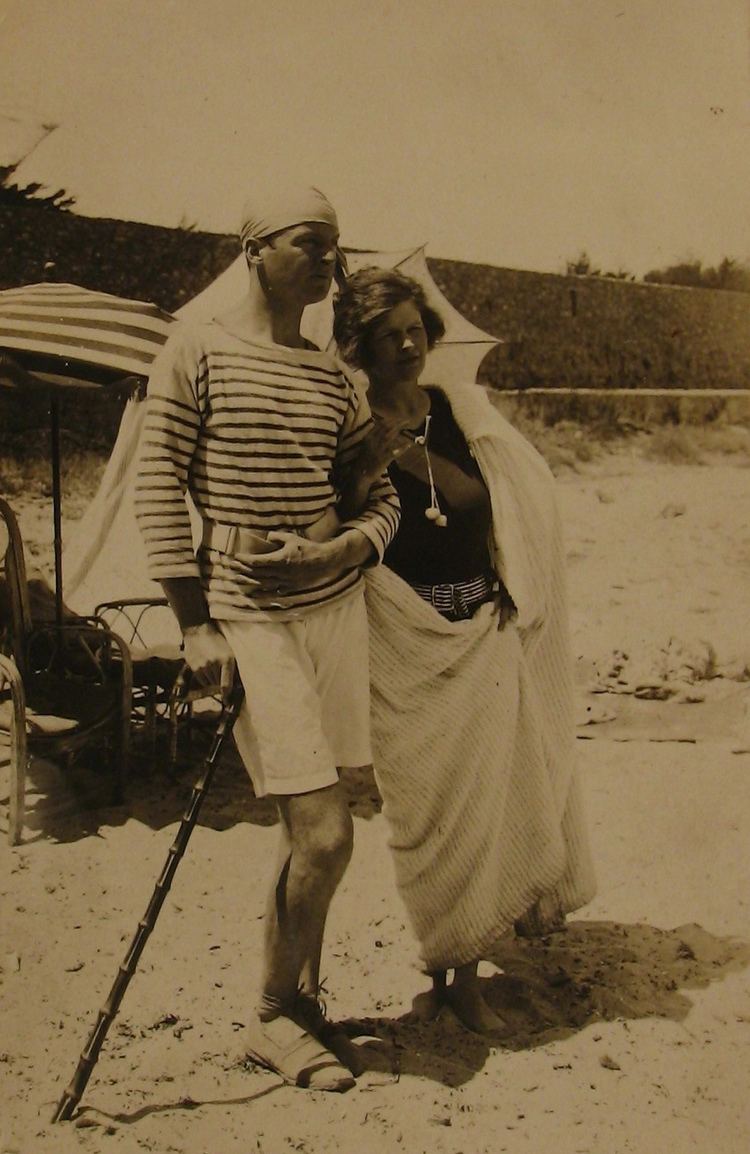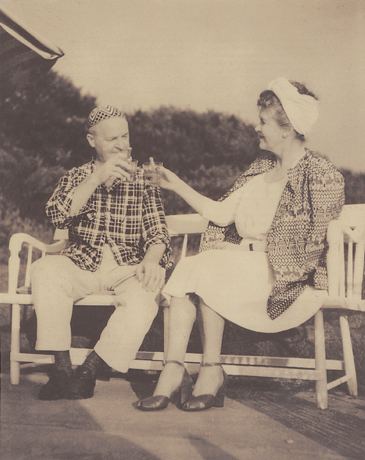Name Gerald Sara Died October 17, 1964 | Role Artist | |
Gerald and sara murphy gravestones east hampton
Gerald Clery Murphy and Sara Sherman Wiborg were wealthy, expatriate Americans who moved to the French Riviera in the early 20th century and who, with their generous hospitality and flair for parties, created a vibrant social circle, particularly in the 1920s, that included a great number of artists and writers of the Lost Generation. Gerald had a brief but significant career as a painter.
Contents
- Gerald and sara murphy gravestones east hampton
- Gerald Murphy
- Sara Sherman Wiborg
- Marriage
- Death and legacy
- Paintings by Gerald Murphy
- Paintings of Sara Murphy by Picasso
- Archives
- References

Gerald Murphy

Gerald Clery Murphy (March 25, 1888 – October 17, 1964) was born in Boston to the family that owned the Mark Cross Company, sellers of fine leather goods. He was of an Irish American background.

Gerald was an aesthete from his childhood onwards. He was never comfortable in the boardrooms and clubs for which his father was grooming him. He failed the entrance exams at Yale three times before matriculating, although he performed respectably there. He joined DKE and the Skull and Bones society. He befriended a young freshman named Cole Porter (Yale class of 1913) and brought him into DKE. Murphy also introduced Porter to his friends, propelling him into writing music for Yale musicals.
Sara Sherman Wiborg

Sara Sherman Wiborg (November 7, 1883 – October 10, 1975) was born in Cincinnati, Ohio, into the wealthy Wiborg family. Her father, manufacturing chemist and owner of his own printing ink and varnish company Frank Bestow Wiborg, was a self-made millionaire by the age of 40, and her mother was a member of the noted Sherman family, daughter of Hoyt Sherman, and niece to Civil War General William Tecumseh Sherman. Raised in Cincinnati, her family moved to Germany for several years when she was a teenager, so her father could concentrate on the European expansion of his company. The Wiborg family was easily accepted into the high society community of 20th-century Europe. While in Europe, Sara and her sisters Hoytie and Olga sang together at high-class assemblies. Upon returning to the United States, the Wiborgs spent most of their time in New York City and, later, East Hampton, where they built the 30-room mansion "The Dunes" on 600 acres just west of the Maidstone Club in 1912. It was the largest estate in East Hampton up to that time. Wiborg Beach in East Hampton is named for the family.
Marriage

In East Hampton Sara Wiborg and Gerald Murphy met when they were both adolescents. Gerald was five years younger than Sara, and for many years they were more familiar companions than romantically attached; they became engaged in 1915, when Sara was 32 years old. Sara's parents did not approve of their daughter marrying someone "in trade," and Gerald's parents were not much happier with the prospect, seemingly because his father found it difficult to approve anything that Gerald did.

After marrying they lived at 50 West 11th Street in New York City, where they had three children. In 1921 they moved to Paris to escape the strictures of New York and their families' mutual dissatisfaction with their marriage. In Paris Gerald took up painting, and they began to make the acquaintances for which they became famous. Eventually they moved to the French Riviera, where they became the center of a large circle of artists and writers of later fame, especially Zelda and F. Scott Fitzgerald, Ernest Hemingway, John Dos Passos, Fernand Leger, Jean Cocteau, Pablo Picasso, Archibald MacLeish, John O'Hara, Cole Porter, Dorothy Parker and Robert Benchley.

Prior to their arrival on the French Riviera, the region was experiencing a period when the fashionable only wintered there, abandoning the region during the high summer months. However, the activities of the Murphys fueled the same renaissance in arts and letters as did the excitement of Paris, especially among the cafes of Montparnasse. In 1923 the Murphys convinced the Hotel du Cap to stay open for the summer so that they might entertain their friends, sparking a new era for the French Riviera as a summer haven. The Murphys eventually purchased a villa in Cap d'Antibes and named it Villa America; they resided there for many years. When the Murphys arrived on the Riviera, lying on the beach merely to enjoy the sun was not a common activity. Occasionally, someone would go swimming, but the joys of being at the beach just for sun were still unknown at the time. The Murphys, with their long forays and picnics at La Garoupe, introduced sunbathing on the beach as a fashionable activity.
They had three children, Baoth, Patrick, and Honoria. In 1929, Patrick was diagnosed with tuberculosis. They took him to Switzerland, and then returned to the U.S. in 1934, where Gerald stayed in Manhattan to run Mark Cross, serving as president of the company from 1934 to 1956; he never painted again. Sara settled in Saranac Lake, New York to nurse Patrick, and Baoth and Honoria were put in boarding schools. In 1935, Baoth died unexpectedly of meningitis as a complication of measles, and Patrick succumbed to TB in 1937. Archibald MacLeish based the main characters in his play J.B. on Gerald and Sara Murphy.
Later they lived at "The Dunes", once the largest house in East Hampton. By 1941, the house proved impossible to rent, sell or even maintain; the Murphys had it demolished, and they themselves moved to the renovated dairy barn.
Death and legacy
Gerald died October 17, 1964 in East Hampton, two days after his friend Cole Porter. Sara died on October 10, 1975 in Arlington, Virginia.
Nicole and Dick Diver of Tender Is the Night by F. Scott Fitzgerald are widely recognized as having been based on the Murphys, mainly from the marked physical similarities, although many of their friends, as well as the Murphys themselves, saw as much or more of Zelda and Scott Fitzgerald's relationship and personalities in the couple than those of the Murphys. Ernest Hemingway's couple in "The Garden of Eden" is not explicitly based on this pair, but given the similarities of the setting (Nice) and of the type of social group portrayed, there is clearly some basis for such an assumption. Interestingly, guests of the Murphys would often swim at Eden Roc, an event emulated in Hemingway's narrative.
Calvin Tomkins's biography of Gerald and Sara Murphy Living Well Is the Best Revenge was published in 1971, and Amanda Vaill documented their lives in the 1995 book Everybody Was So Young. Both accounts are balanced and kind, unlike some of their portrayals in the memoirs and fictitious works by their many friends, including Fitzgerald and Hemingway.
In 1982, Honoria Murphy Donnelly, the Murphys' daughter, with Richard N. Billings, wrote Sara & Gerald: Villa America and After.
On July 12, 2007, a play by Crispin Whittell entitled Villa America, based entirely on the relationships between Sara and Gerald Murphy and their friends had its world premiere at the Williamstown Theatre Festival with Jennifer Mudge playing Sara Murphy.
Paintings by Gerald Murphy
Gerald only painted from 1921 until 1929; he is known for his hard-edged still life paintings in a Precisionist, Cubist style. During the 1920s Gerald Murphy, along with other American modernist painters in Europe, notably Charles Demuth and Stuart Davis created paintings prefiguring the pop art movement that contained pop culture imagery, such as mundane objects culled from American commercial products and advertising design.
Gerald Murphy’s jazz-rhythmed painting entitled Razor (1924) and the 6-by-6-foot Watch (1925) are part of the Dallas Museum’s permanent collection and are two of eight remaining paintings in Murphy’s 14-work oeuvre. [2]
Paintings of Sara Murphy by Picasso
Pablo Picasso, a friend of Sara's, painted her in several of his 1923 works:
Archives
The Sara and Gerald Murphy Papers are held at the Beinecke Rare Book and Manuscript Library at Yale University. Some Mark Cross Company objects are also located at the Metropolitan Museum of Art.
